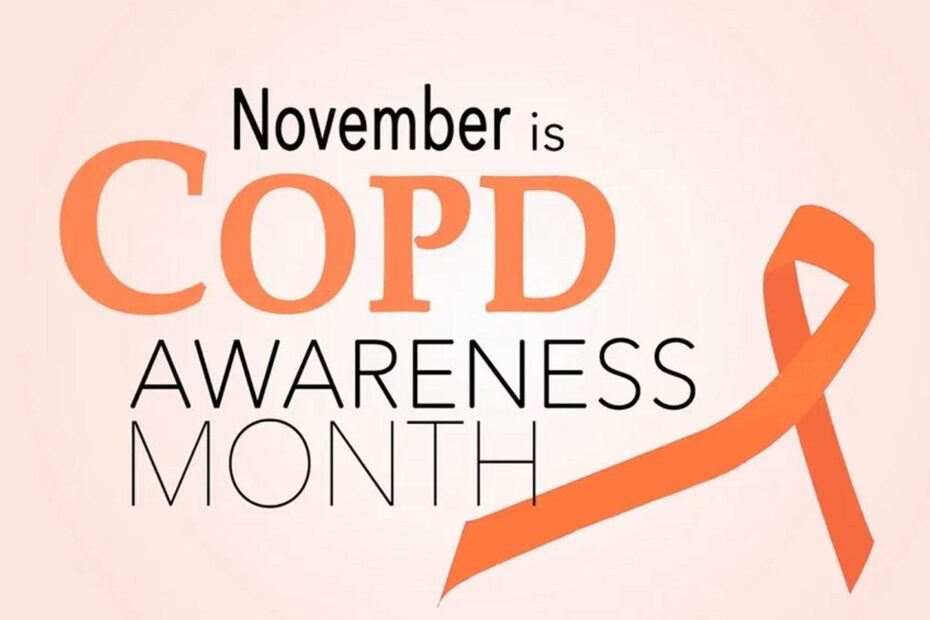Chronic obstructive pulmonary disease (COPD) is a serious, progressive lung disease affecting millions globally. COPD Awareness Month 2024 this November shines a light on the condition, aiming to educate, support and empower people impacted by COPD.
From sharing preventive strategies to advocating for advancements in treatment, the month is an essential time for spreading awareness and understanding.
The COPD Foundation’s theme for this year’s COPD Awareness Month is “Lace-Up for Lungs,” which encourages people to get moving for at least 30 minutes every day in November. It also suggests people share their daily activity progress in the campaign’s Facebook group, where people can invite friends, family and people in their community to join.
People can also start a fundraiser to support research, education, community and advocacy for people affected by chronic lung disease.
Within COPD Awareness Month is World COPD Day, which falls on November 20. On this day, the campaign includes “Wear Orange Day!” where people are encouraged to wear orange and invite family, friends, co-workers and members of the community to do the same.
People can take a picture of their orange outfit and share it on social media. The COPD Foundation says it invites people to tag it on social media platforms using hashtags such as #WorldCOPDDay and #LaceUpForLungs.
These are just some of the activities that the COPD Foundation and its community organize during COPD Awareness Month.
What Is COPD?
COPD is an umbrella term for a group of lung diseases, primarily including chronic bronchitis and emphysema, that block airflow and make breathing difficult. Over time, COPD can worsen, leading to symptoms such as persistent coughing, increased mucus production, shortness of breath and wheezing.
COPD is often preventable, yet it remains a leading cause of death worldwide. In 2021, COPD was the fourth leading cause of death worldwide and the sixth in the US. Millions of people are undiagnosed as they remain unaware that they have the disease.
COPD: Who it Affects, Symptoms
COPD primarily affects people over the age of 40, especially those with a history of smoking, but anyone exposed to long-term air pollution, chemical fumes or dust can develop COPD. Family history and certain genetic factors also play a role in susceptibility.
According to the World Health Organization (WHO), approximately 65 million people globally have moderate-to-severe COPD, and many cases remain undiagnosed. In the US, around 11 million people are currently living with the condition.
COPD has several symptoms that often develop slowly over time. Key ones include:
- Persistent cough: Often referred to as a “smoker’s cough,” this is a chronic cough that can produce mucus or phlegm.
- Shortness of breath: Especially noticeable during physical activities or even during simple tasks as the disease progresses.
- Wheezing: A whistling or squeaky sound when breathing, which happens due to narrowed airways.
- Excess mucus production: COPD can cause excess mucus in the airways, leading to frequent throat clearing.
- Chest tightness: Many people experience a feeling of tightness or pressure in their chest.
- Frequent respiratory infections: Those with COPD are more susceptible to colds, flu and other respiratory infections.
- Fatigue: COPD makes breathing more labor-intensive, leading to fatigue even with mild activity.
- Cyanosis: A bluish tint to the lips or fingernail beds due to low oxygen levels in the blood, which is a more advanced symptom.
Since COPD symptoms develop gradually, many people attribute them to aging or other issues, which often leads to delayed diagnosis.
COPD Treatments
Treatment for COPD focuses on managing symptoms, slowing disease progression, preventing complications and improving overall quality of life. While there’s no cure for COPD, a variety of treatments can help.
Medications
Medications for managing COPD include a range of options to ease symptoms and prevent exacerbations.
Bronchodilators are one of the primary treatments, helping to relax the muscles around the airways to make breathing easier; they come in both short-acting forms for quick relief and long-acting options for sustained symptom control.
Inhaled steroids are another key option, working to reduce inflammation in the airways, particularly beneficial for those with frequent exacerbations.
For some patients, combination inhalers that mix bronchodilators and steroids may provide enhanced effectiveness.
In cases of flare-ups, oral steroids are often prescribed for short-term use to control inflammation.
Additionally, antibiotics can be used to treat or prevent respiratory infections, which, if left untreated, can worsen COPD symptoms.
Oxygen Therapy
For those with advanced COPD and low blood oxygen levels, supplemental oxygen can improve energy levels and quality of life. Oxygen therapy can be provided in a home setting and used as needed or continuously.
Pulmonary Rehabilitation
Pulmonary rehab is a comprehensive program that combines exercise, breathing techniques, nutrition counseling and education. It’s designed to help patients improve lung function, manage symptoms and maintain physical activity safely.
Lifestyle Modifications
Lifestyle modifications play a critical role in managing COPD and improving overall quality of life.
Quitting smoking is the most impactful step, as it directly slows the progression of COPD by preventing further lung damage.
Regular exercise is also essential; staying active helps strengthen muscles, making daily tasks more manageable and enhancing endurance.
A healthy diet complements these efforts by providing balanced nutrition, which supports energy levels — especially important, as breathing difficulties can increase the body’s calorie needs.
Together, these lifestyle changes can significantly aid in managing COPD symptoms and maintaining a better quality of life.
Surgery
In advanced cases where medications and other therapies aren’t enough, surgery might be an option.
Surgical options for managing COPD include lung volume reduction surgery (LVRS), which involves removing damaged lung tissue to help the healthier parts of the lung to function more effectively.
Another option, a bullectomy, removes large air spaces (bullae) that form in damaged lung tissue, helping to improve airflow.
In severe cases where other treatments have not been effective, a lung transplant may be considered, though it is reserved strictly for patients with no other viable treatment options.
Vaccinations and Preventive Care
People with COPD are more vulnerable to respiratory infections, which can cause severe complications. Vaccinations, such as annual flu shots and pneumonia vaccines, are essential for preventing infections that could exacerbate symptoms.
Breathing Techniques and Energy Conservation
Learning specialized breathing exercises, such as pursed-lip breathing, helps manage breathlessness. Energy conservation techniques can make daily tasks more manageable.
Each COPD treatment plan is individualized, as disease severity and symptoms vary. With the right approach, many people with COPD can improve their quality of life and manage symptoms effectively.
COPD: Raising Awareness
Raising awareness about COPD during November can help lead to:
- Earlier diagnosis and better outcomes: Many people are unaware of the symptoms or attribute them to aging. Early screening can lead to earlier intervention, which can significantly slow disease progression and improve quality of life.
- Reduction in stigma: Because COPD is often linked to smoking, there can be stigma attached to the disease. Raising awareness helps shift the focus from blame to support and understanding.
- Advocacy for policy and research funding: Awareness initiatives also support the push for more research funding, better policies and improved healthcare access for those affected by COPD.
- Encouragement for quitting smoking and reducing pollution: Prevention is key, and awareness campaigns often emphasize the importance of smoking cessation, minimizing exposure to pollutants and maintaining a healthy lifestyle.
COPD is a preventable, manageable disease, but awareness about the condition is still lacking. COPD Awareness Month strives to increase awareness, educate people about the condition, reduce stigma, support people living with COPD and support research for new COPD treatments.











Join or login to leave a comment
JOIN LOGIN